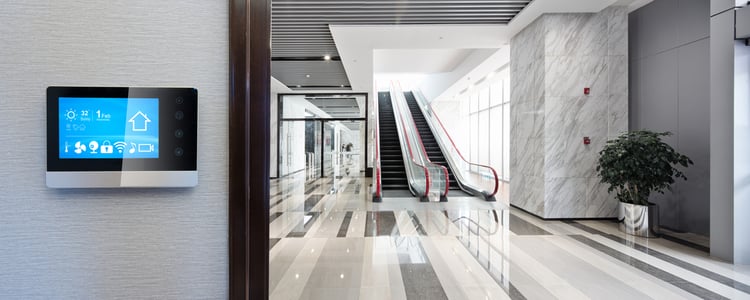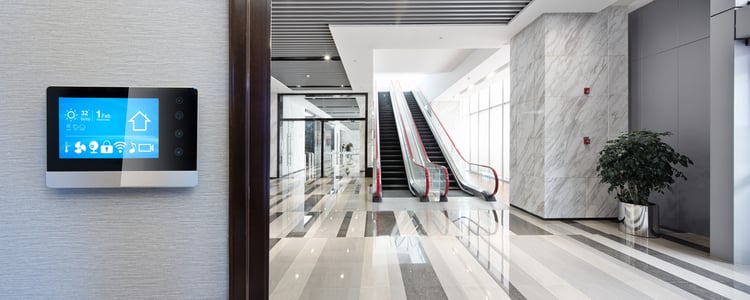HVAC systems are the most energy-consuming loads in residential and commercial buildings. For this reason, energy efficiency measures targeting HVAC can achieve major savings. However, energy-saving HVAC upgrades should not affect indoor environmental quality, or they may cause discomfort and health problems. In business environments, this also has a negative impact on productivity.
Artificial intelligence has promising applications in HVAC as it can improve energy efficiency and indoor environmental quality. AI can optimize variables such as airflow, temperature and humidity – conserving air quality with the lowest possible energy consumption.
Make your HVAC system smarter and more efficient.
HVAC control: a technical challenge
Effectively controlling an HVAC system is difficult because building conditions are always changing. Consider the following aspects:
- The outside temperature is always changing and affects the heating or cooling needed to maintain an adequate indoor temperature.
- People move in and out of buildings all the time, and this affects ventilation and temperature control needs.
- Activities performed indoors also affect HVAC needs. For example, a commercial kitchen needs more ventilation and cooling than an office of the same size.
A building’s ventilation, heating and cooling needs are always changing. Only an intelligent control system can process all this data in real time and adjust the HVAC system accordingly. An HVAC system with manual controls cannot achieve maximum performance due to varying working conditions.
Smart Controls for Ventilation Systems
Air handlers consume less energy than air conditioners and space heaters. However, the flow of outside air supplied to a building affects heating and cooling needs.
- For example, if a ventilation system increases airflow during the winter, more heat is needed for a greater volume of cold outside air.
- The same applies to air conditioning when the ventilation system increases airflow during the summer.
Many buildings have ventilation systems that operate at full airflow at all times. This represents a huge waste of energy, for the reasons described above. When ventilation controls have AI, they can determine the ideal airflow required by the building. The system can also track the number of building occupants and the concentration of key air pollutants such as VOCs and particulates.
Overventilation represents a waste of energy, while underventilation is harmful to indoor air quality. AI ventilation control helps prevent both. There is only one important requirement: the ventilation system must never reduce airflow below the minimum value required by local building codes.
Optimizing space heating and air conditioning

There are now furnaces, boilers, chillers, mini-splits and other HVAC equipment with built-in artificial intelligence. As a result, large energy savings can be expected simply by modernizing old equipment. However, improved performance is possible when smart controls are used for the entire HVAC system.
Just as ventilation controls must balance energy consumption and air quality, heating and cooling controls must balance energy consumption and human comfort. According to a study by the Lawrence Berkeley National Laboratory (LBNL), human productivity peaks at around 21°C – 22°C.
- As the temperature increases or decreases, it begins to cause discomfort.
- When the temperature becomes more extreme, it becomes unhealthy and eventually life-threatening.
Extreme temperatures are unlikely in building interiors, even with poor HVAC installation. However, indoor environmental quality (IEQ) gradually worsens as the temperature deviates from the ideal range.
How AI can achieve synergy with energy efficiency measures
Energy efficiency measures can become more effective when AI is added to the mix, achieving greater savings. Two examples of HVAC upgrades that work best with AI are airside economizers and energy recovery ventilators.
Airside economizers can save a lot of energy in some climates. When the outside air is at the right temperature and humidity for “free cooling,” the economizer increases ventilation rates while reducing conditioned air output. Electricity is saved because fans are cheaper to operate than air conditioners. Smart controls can optimize the airside economizer to maximize these savings.
Energy recovery ventilation also achieves synergy with smart ventilation. When external airflow is optimized, energy is not wasted on heating or cooling extra air. The ERV system can then exchange heat between the supply air and exhaust air, further reducing the HVAC workload. The ERV works with both air conditioning and space heating: indoor air pre-cools outdoor air in summer and pre-heats outdoor air in winter.
Building certifications like LEED and WELL have demanding performance requirements for heating, cooling and ventilation. AI-powered automatic controls can help meet these requirements by optimizing the operation of HVAC systems.
HVAC engineering: the different challenges
You might love turning on the heater during the winter or the air conditioning during the summer. It's quick and easy, but it wasn't always that way. HVAC engineering and the industry are constantly evolving. With the advancement of technology, meeting customer demands is often a challenge.
Here are some of the things the HVAC engineering industry is focusing on right now
1. Be energy efficient
Energy efficiency is what consumers are looking for. The energy crisis of the 1970s, for example, caused countries to focus on conversation and efficiency. This meant that HVAC engineers had to be dynamic and find new ways to perform the same task on lower energy consumption equipment. The abundant use of fossil fuels has become a concern.
Today's consumers also understand the need for energy efficiency and its impact on overall cost. HVAC systems are much more energy efficient today than ever before, but more needs to be done. We're sure you don't want high heating bills every winter!
2. Finding the right equipment
For HVAC engineers, coordination with architects, civil engineers, structural engineers, plumbing engineers, and electrical engineers prior to installation remains a concern. Here are some things HVAC engineers should watch out for.
- The location, size of equipment, and positioning of equipment to be used during the design process.
- The type of material used in the construction of the building is also a factor in the equipment to be used.
- The landscape can also impact thermal loads.
- Following building codes, fire and safety codes.
3. Customer Demands
Customers are looking for more. Providing the best building solutions within budget is a challenging aspect when it comes to HVAC engineering. You need to design the layout, what material to use, and even what material to use.
All this ensuring that the low budget will not affect the overall quality. In the long run, customers would not want to incur high maintenance costs.
4. The Weather
Every place is different. HVAC systems need to function properly even when weather conditions are extreme. HVAC engineering needs to keep air conditioning and ventilation running to maintain indoor temperatures.
To do this, engineers must keep in mind several factors such as:
- The external temperature,
- The number of people,
- The distribution of ventilation throughout all areas of the building.
They also need to work on controlling humidity and ensuring no mold forms. Furthermore, it is necessary to calculate the internal and external air pressure to avoid any undesirable formation of humidity inside the building.
5. To maintain IAQ
Maintaining Indoor Air Quality (IAQ) is another challenge. HVAC engineers need to keep in mind the design factor and that airborne diseases cannot survive indoors. The question here is: if the outside air quality is bad, how would you guarantee better indoor air quality?
Although challenges remain, it is no secret that the industry will continue to experience significant growth. The HVAC Engineering industry in the US alone is estimated to generate revenues of more than 60 million dollars in the next twelve months.
Technical standards used by an HVAC engineer
The work of an HVAC Engineer includes designing heating, ventilation and air conditioning systems according to the needs of each building. There are many organizations in the HVAC industry and they have published standards to ensure the correct design and installation of these important building systems. HVAC standards apply throughout the US and local building codes typically use them as a reference – some standards have even been adopted internationally.
An HVAC installation must maintain indoor conditions suitable for human occupancy, and these include ambient temperature, relative humidity, and outdoor air supply. HVAC systems are characterized by their high energy consumption, surpassing all other building systems combined in residential and commercial applications. Energy efficiency measures are strongly recommended to reduce your operating cost.
The following are some of the major industry associations that publish technical standards for HVAC systems:
- ACCA – Air Conditioning Contractors of America
- ARI – Institute of Air Conditioning and Refrigeration
- ASHRAE – American Society of Heating, Refrigerating and Air-Conditioning Engineers
- NFPA – National Fire Protection Association
- SMACNA – National Association of Sheet Metal and Air Conditioning Contractors
How an HVAC engineer applies standards in project design
Technical standards provide calculation procedures for many aspects of HVAC design that are considered industry best practices. For example, the ASHRAE Handbook is one of the most important standards for mechanical engineers and consists of four volumes: Fundamentals, Refrigeration, HVAC Applications, and HVAC Systems and Equipment.
The ASHRAE Manual is constantly reviewed and updated by technical committees. An ASHRAE member HVAC engineer receives the latest edition each year as one of the benefits of membership. The Manual is available in printed, CD-ROM and online versions.
ASHRAE also has Standard 90.1, which has been used nationally and internationally to improve the energy efficiency of buildings, and many local energy codes use it as a benchmark. Standard 90.2 is similar, but with a focus on low-rise residential construction.
ACCA has published a set of technical manuals with calculation procedures for many aspects of HVAC design, as well as equipment selection guidelines. There are residential and commercial versions of the ACCA manuals, covering the following topics:
- System concept
- Load calculation
- System zoning
- Air distribution
- Equipment selection
- Duct Size Calculation
- Adjustment, testing and balancing
SMACNA standards are very important in HVAC installations that utilize air ducts because they provide design requirements for sheet metal and fiberglass ducts. By following the calculation procedures of SMACNA standards, HVAC engineers can ensure that air ducts are sized appropriately while meeting airflow and static pressure requirements.
NFPA standards address fire protection, which is a very important aspect for heating equipment that burns natural gas, heating oil, or any other fuel. One of the NFPA standards is the National Electrical Code (NEC) – it applies to all circuits that supply power to HVAC installations, as well as their protection systems.
Industry standards may seem overwhelming at first glance, but they guarantee high performance and safety when designing building systems. A qualified HVAC engineer is familiar with all applicable standards and can use them effectively during the design process.




